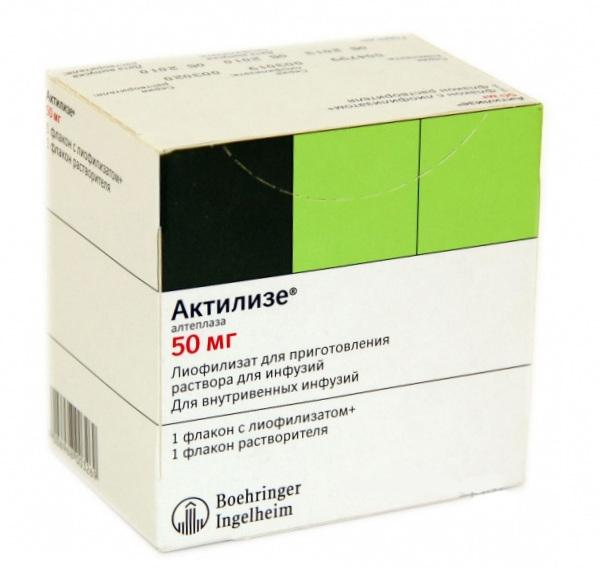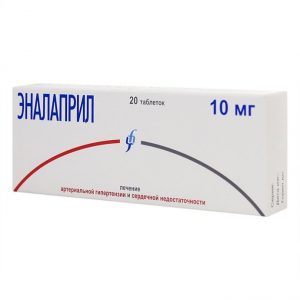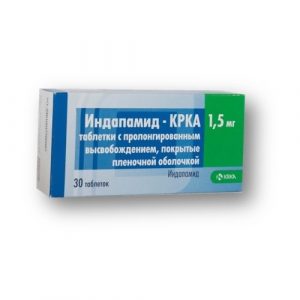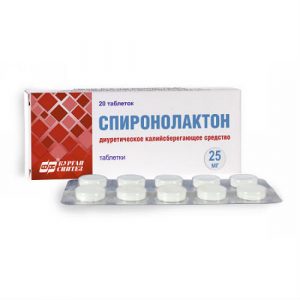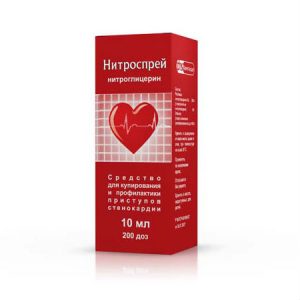Description
Release form
freeze-dried powder.
Packing
1 fl.
Pharmacological action
Thrombolytic. Recombinant human tissue plasminogen activator, glycoprotein.
With iv administration, the drug is relatively inactive in the systemic circulation. It is activated after binding to fibrin, inducing the conversion of plasminogen to plasmin, which leads to the dissolution of the fibrin clot.
With the use of Actilize, the release of the enzyme alpha-hydroxybutyrate dehydrogenase is reduced.
The use of 100 mg Aktilis for 90 min in conjunction with iv administration of heparin in more than 40,000 patients with acute myocardial infarction (GUSTO studies) led to a decrease in 30-day mortality (6.3%) compared with streptokinase (1.5 million units over 60 minutes) simultaneously with subcutaneous or iv administration of heparin (7.3%). It was shown that after 60 min and 90 min of thrombolysis in patients receiving Actilize, a higher frequency of restoration of vascular patency in the infarction zone was detected than with streptokinase. 180 minutes after the start of therapy and later, there were no differences in the frequency of vascular patency.
With the use of Aktilis, there was a decrease in 30-day mortality after myocardial infarction compared with patients who did not receive thrombolytic therapy.
In patients receiving Actilize, Compared with patients who did not receive thrombolytic therapy, less significant damage to the overall function of the left ventricle of the heart and local mobility of the walls was noted.
A placebo-controlled study (LATE) showed that the use of Aktilis at a dose of 100 mg for 3 hours in patients with myocardial infarction (in the case of initiation of therapy within 6-12 hours after the onset of symptoms), led to a decrease in 30-day mortality compared to placebo. The therapeutic effect in patients with confirmed myocardial infarction was also noted in those cases when treatment began within 24 hours after the onset of symptoms.
In patients with acute massive pulmonary embolism, accompanied by unstable hemodynamics, the use of Actilise leads to a rapid decrease in the size of the blood clot and a decrease in pressure in the pulmonary artery, however, mortality data are not available.
In two studies in the USA (NINDS A / B), which studied the effect of the drug on stroke (in the first 3 hours after the onset of symptoms), a more frequent achievement of a favorable result was established (absence of impaired patient capacity or minimal severity of these disorders) compared to placebo.
If therapy is started at a later date, the effectiveness of the drug decreases, which was shown in two European studies and in an additional study conducted in the USA.
The results of a meta-analysis of all patients receiving therapy within the first 3 hours after the onset of a stroke confirmed the presence of a positive effect of alteplase.
Despite the increased risk of serious and even fatal intracranial hemorrhages, the likelihood of a favorable outcome for therapy compared to placebo was 14.9% (95% confidence intervals: 8.1% and 21.7%). These data do not allow a definitive conclusion regarding the effect of therapy on mortality. The benefit / risk ratio in the case of alteplase within 3 hours after the onset of the stroke (taking into account the above warnings) can generally be considered favorable, although the research data do not allow an unambiguous conclusion regarding the effect of therapy on mortality.
A meta-analysis of all available clinical data shows that alteplase is less effective in patients whose treatment begins 3-6 hours after the onset of symptoms, compared with therapy, undertaken in the first 3 hours after the development of clinical manifestations. In this case, the risk of complications of stroke therapy in the first case is higher, which leads to an unfavorable outcome of the benefit / risk ratio.
Due to the relative specificity for fibrin, the use of alteplase at a dose of 100 mg leads to a moderate decrease in the level of circulating fibrinogen (approximately 60% after 4 hours), which usually increases by more than 80% by 24 hours. Concentrations of plasminogen and alpha-2-antiplasmin after 4 hours decrease, respectively, to 20% and 35% of the initial levels, and after 24 hours they again increase to more than 80%. A significant and lasting decrease in the level of circulating fibrinogen was observed in only a small number of patients.
Indications
– thrombolytic therapy for acute myocardial infarction in the first 6 hours after the onset of symptoms (90-minute / accelerated / dosing regimen)
– thrombolytic therapy for acute myocardial infarction for 6 to 12 hours after the development of symptoms (3-hour dosing regimen )
– thrombolytic therapy of acute massive pulmonary thromboembolism, accompanied by unstable hemodynamics, the diagnosis should, if possible, be confirmed objectively (for example, angiography of the pulmonary artery or non-invasive m todami, e.g., lung imaging). No clinical studies regarding mortality and long-term outcomes of treatment for pulmonary embolism
– thrombolytic therapy of acute ischemic stroke (shown only if if it is prescribed within 3 hours after the development of symptoms of a stroke, and if intracranial hemorrhage (hemorrhagic stroke) is excluded using appropriate imaging methods, for example, computed tomography of the brain).
Contraindications
– hemorrhagic diathesis
– bleeding at present or within the previous 6 months
– concomitant use of oral anticoagulants (e.g. warfarin international normalized ratio> 1.3)
– a history of central nervous system history (e.g. )
– surgical intervention on the brain or spinal cord
– intracranial (including subarachnoid) hemorrhages, currently or in the history of
– suspected hemorrhagic stroke
– severe uncontrolled arterial hypertension
– extensive surgery or severe trauma over the previous 10 days (including any trauma associated with this acute myocardial infarction – srd) traumatic brain injury
– prolonged or traumatic cardiopulmonary resuscitation (more than 2 min), childbirth within the previous 10 days
– recently performed puncture of incompressible even vessels (for example, subclavian and jugular veins)
– hemorrhagic retinopathy (including diabetes mellitus), visual impairment
– other hemorrhagic eye diseases
– bacterial endocarditis
– pericarditis
– acute pancreatitis
– confirmed peptic ulcer of the stomach and duodenum during the last 3 months
– severe liver disease, including liver disease, including liver disease, portal hypertension (with varicose veins of the esophagus), active hepatitis
– arterial aneurysms, congenital malformations of arteries and veins
– neoplasms with an increased risk of srotlkp leaks – increased sensitivity to the components of the drug.
In the case of the use of the drug for the treatment of acute myocardial infarction and pulmonary embolism, in addition to the above contraindications, the following contraindication exists: – history of stroke. 25) and / or according to the results of appropriate visualization methods
– cramps at the beginning of a stroke
– information about a stroke or serious head injury within 3 previous months
– the onset of a previous stroke against diabetes
– heparin within 48 hours before stroke, if at the given time the activated partial thrombin time (APTT) is increased
– use of antiplatelet agents at the time of infusion and within 24 hours after infusion
– platelet count less than 100,000 / mm3 *
– system The blood pressure is higher than 185 mm Hg. Art., or diastolic blood pressure above 110 mm RT. Art., or it is necessary to use intensive therapy (iv administration of drugs) to lower blood pressure to these boundaries
– blood glucose less than 50 mg / dl or more than 400 mg / dl.
Actilize is not indicated for the treatment of acute stroke in children and adolescents under the age of 18 years and in adults over the age of 80 years.
Use during pregnancy and lactation
Clinical experience with Aktilis during pregnancy and lactation is limited. The issue of the allocation of alteplase with breast milk has not been studied.
If you need to use the drug (diseases that directly threaten life) during pregnancy and lactation, the expected benefits of therapy for the mother and the potential risk to the fetus or infant should be assessed.
Special instructions
In the following cases, when prescribing Aktilis, the degree of expected benefit and possible risk of bleeding should be carefully assessed: – a recent i / m injection or small recent interventions such as a biopsy, large blood vessel puncture, cardiac massage during
resuscitation – diseases not mentioned in the list of contraindications), at which the risk of bleeding is increased.
In the treatment of acute myocardial infarction and acute pulmonary embolism, the drug should be used with caution: – with systolic blood pressure above 160 mm Hg. Art.
– in old age, when the risk of intracranial hemorrhage may increase. Since elderly patients are also more likely to have a positive outcome for this treatment, a thorough assessment of the benefit / risk ratio is necessary.
In the treatment of acute ischemic stroke, use the drug with caution, because the use of Actilise in this category of patients (compared with the use of this drug for other indications) is accompanied by a markedly increased risk of intracranial hemorrhage, since bleeding occurs mainly in the necrotic region.
This should be especially taken into account in the following cases: – all the conditions listed in the Contraindications section, and in general all conditions with a high risk of bleeding
– the presence of small asymptomatic cerebral vascular aneurysms
– in patients who have previously been treated with acetylsalicylic acid or other antiplatelet agents, an increased risk of intracerebral hemorrhage is possible, especially if the use of Actilize is started at a later date. Given the increased risk of cerebral hemorrhage, the dose of alteplase used should not exceed 900 mcg / kg (maximum dose is 90 mg).
Treatment should not be started later than 3 hours after the onset of symptoms, due to the unfavorable benefit / risk ratio, due to the following circumstances:increases predominantly in patients previously treated with
acetylsalicylic acid – the risk of bleeding increases.
Aktilize treatment should be carried out by a doctor with experience in conducting thrombolytic therapy and the ability to monitor its effectiveness. When using Aktilis, it is recommended to have standard resuscitation equipment and appropriate medicines available.
The most common complication of Actilise therapy is bleeding. The simultaneous use of heparin can contribute to bleeding. Because Actilize dissolves fibrin, bleeding from recent puncture sites may occur. Therefore, thrombolytic therapy requires careful monitoring of areas of possible bleeding (including the injection site of the catheter, arterial and venous punctures, incisions and injections). The use of hard catheters, v / m injections and unreasonable manipulations during the treatment of Actilize should be avoided.
In the event of severe bleeding, especially cerebral, fibrinolytic therapy, as well as the use of heparin should be stopped immediately. In the event that heparin was used within 4 hours before the onset of bleeding, the advisability of using protamine should be considered. In rare cases where the above conservative measures are ineffective, the use of blood products may be indicated. Transfusion administration of cryoprecipitate, freshly frozen plasma and platelets can be prescribed in accordance with clinical and laboratory parameters, which are determined again after each administration. The cryoprecipitate infusion is preferably carried out until the fibrinogen concentration reaches 1 g / l. You can consider the use of antifibrinolytic agents (for example, tranexamic acid), but no special studies have been conducted.
In acute myocardial infarction and pulmonary embolism, Aktilis should not be used in a dose exceeding 100 mg, and in acute ischemic stroke – in a dose of more than 90 mg, because increased risk of intracranial hemorrhage.
After the end of treatment, no stable formation of antibodies to the recombinant human activator of tissue plasminogen was observed. There is no systematic experience with the repeated use of Actilize. If an anaphylactoid reaction develops, the infusion should be discontinued and appropriate treatment prescribed. Regular monitoring of treatment tolerance is recommended. especially in patients simultaneously receiving ACE inhibitors.
In the treatment of acute myocardial infarction, the following precautions should be borne in mind: – coronary thrombolysis can lead to arrhythmias associated with
reperfusion – there is no experience with the use of glycoprotein IIb / IIIa antagonists within the first 24 hours after starting treatment – thrombolytic agents may increase the risk of thromboembolism in patients with left heart thrombosis, for example, with mitral stenosis or with atrial fibrillation.
In the treatment of acute stroke, the following precautions should also be taken into account.
Treatment should be carried out exclusively by an experienced doctor with the skills and experience in providing intensive neurological care, in a specialized department, having the opportunity to conduct the full range of neuroimaging studies.
It is necessary to monitor blood pressure during treatment and within 24 hours after its completion. With an increase in systolic blood pressure above 180 mm RT. Art. or diastolic blood pressure below 105 mm Hg. Art. recommended in / in the use of antihypertensive drugs.
The therapeutic effect is reduced in patients who have had a previous stroke, or in the presence of uncontrolled diabetes mellitus. In such patients, the benefit / risk ratio is considered less favorable, although it remains positive. In patients with a very small stroke, the risk exceeds the expected benefit, so the use of Aktilis is not recommended.
Patients with very severe stroke have an increased risk of intracranial bleeding and death. In these cases, Aktilis should not be used.
Patients with extensive cerebral infarction have an increased risk of adverse outcomes, including severe intracerebral hemorrhage and death. In such cases, the risk and benefits of therapy should be carefully weighed.
In stroke, the likelihood of a favorable treatment outcome decreases with increasing age, as well as with increasing severity of the stroke and with elevated blood glucose levels. At the same time, the likelihood of serious impairment of legal capacity and death or serious intracranial hemorrhage increases regardless of treatment. Aktilisa should not be used in patients older than 80 years, in case of severe stroke (according to clinical data and / or according to imaging studies) and in cases where the initial values ² ¹ ² ¹of blood glucose are less than 50 mg / dl or more than 400 mg / dl.
Reperfusion of the ischemic region can lead to cerebral edema in the infarction zone. Due to the increased risk of hemorrhage, the use of platelet aggregation inhibitors should not be started within the first 24 hours after thrombolysis with alteplase.
Pediatric use
Currently, experience with Aktilize in children is limited.
Composition
1 vial. contains alteplase 50 mg.
Dosage and Administration
Aktilis should be used as soon as possible from the moment the symptoms occur.
In case of myocardial infarction with a 90-minute (accelerated) dosing regimen for patients in whom treatment can be started within 6 hours after the onset of symptoms, the drug is prescribed at a dose of 15 mg iv in a stream, then 50 mg in the form of iv infusion during the first 30 minutes, followed by 35 mg infusion over 60 minutes until a maximum dose of 100 mg is reached.
In patients with a body weight of less than 65 kg, the dose should be calculated depending on body weight. Initially, the drug is prescribed at a dose of 15 mg iv in a jet, then 750 mcg / kg body weight (maximum 50 mg) for 30 minutes iv in a drip, followed by infusion of 500 mcg / kg (maximum 35 mg) for 60 minutes .
For myocardial infarction with a 3-hour dosing regimen for patients in whom treatment can be started between 6 hours and 12 hours after the onset of symptoms, the drug is prescribed at a dose of 10 mg iv in a stream, then 50 mg as an iv infusion for the first hour, followed by an intravenous infusion of 10 mg for 30 minutes until a maximum dose of 100 mg is reached within 3 hours.
In patients weighing less than 65 kg, the total dose should not exceed 1.5 mg / kg.
Recommended maximum dose of Aktilis in acute myocardial infarction is 100 mg.
Auxiliary therapy: acetylsalicylic acid should be prescribed as soon as possible after the onset of thrombosis and continue to be taken for the first months after myocardial infarction. The recommended dose is 100-300 mg / day. At the same time, heparin should be started for a period of 24 hours or more (with an accelerated dosing regimen – at least 48 hours). It is recommended to start with iv injection of heparin at a dose of 5000 U / h before starting thrombolytic therapy. Subsequently, heparin is administered infusion at a rate of 1000 U / h. The dose of heparin should be adjusted depending on the results of the repeated determination of APTT (the values should exceed the initial level by 1.5-2.5 times).
In case of pulmonary embolism, Aktilis is administered in a total dose of 100 mg for 2 hours. The most experience was obtained using the following dosage regimen: first, the drug is prescribed at a dose of 10 mg iv in a stream for 1-2 minutes, then 90 mg iv in a drip for 2 hours. In patients with a body weight of less than 65 kg, the total dose should not exceed 1.5 mg / kg of body weight.
Auxiliary therapy: after the use of Aktilis, if the APTT is less than 2 times higher than the initial level, heparin should be prescribed (or continued). Further infusion is also carried out under the control of APTT, which should not exceed the initial level by more than 1.5-2.5 times.
For ischemic stroke, the recommended dose is 900 mcg / kg (maximum 90 mg), given as an iv infusion for 60 minutes after the initial iv injection of a dose of 10% of the total dose. Therapy should be started as soon as possible after the onset of symptoms (preferably within 3 hours).
Adjunctive therapy: The safety and effectiveness of the above treatment regimen, used in combination with heparin and acetylsalicylic acid in the first 24 hours after the onset of symptoms, have not been adequately studied. In this regard, in the first 24 hours after the start of Aktilis therapy, the use of acetylsalicylic acid or iv administration of heparin should be avoided. If the use of heparin is required for other indications (for example, for the prevention of deep vein thrombosis), its dose should not exceed 10,000 IU per day, while the drug is administered sc.
Side effects of
The most common side effect is bleeding, which leads to a decrease in hematocrit and / or hemoglobin.
Bleeding associated with thrombolytic therapy can be divided into two main categories: – external bleeding (usually from puncture sites or damage to blood vessels)
– internal bleeding from the gastrointestinal tract, genitourinary tract, bleeding into the retroperitoneal space, hemorrhage in the brain or bleeding from parenchymal organs.
The following data are based on the results of Aktilis clinical trials in 8299 patients with acute myocardial infarction.
A case of cholesterol crystals embolization not observed in a population of patients participating in clinical trials is based on a separate report.
In comparison with studies on myocardial infarction, the number of patients with pulmonary embolism and stroke who participated in clinical trials (within 0-3 hours from the onset of symptoms of these diseases) was very small. Therefore, small numerical differences observed when comparing with data obtained with myocardial infarction were most likely the result of a small sample size. In addition to intracranial hemorrhage (as a side effect of a stroke) and reperfusion arrhythmias (as a side effect of a myocardial infarction), there are no clinical grounds to suggest qualitative and quantitative differences in the spectrum of side effects of the drug Aktilize if it is used for pulmonary embolism and acute ischemic stroke, or with myocardial infarction.
Side effects observed with
myocardial infarction. Very common: reperfusion arrhythmias, which can be life threatening and require the use of conventional antiarrhythmic therapy.
side effects,
noted for use in myocardial infarction and pulmonary embolism Rarely: intracranial hemorrhage.
Side effects seen with acute ischemic stroke
Often: intracranial hemorrhage. The main adverse event was clinically pronounced intracranial hemorrhage (their frequency reached 10%). However, no
was found to increase the incidence of complications or overall mortality.
Side effects seen with myocardial infarction, pulmonary embolism, and acute ischemic stroke
Very often: external bleeding, usually from puncture sites or from damaged blood vessels, decreased blood pressure.
Often: gastrointestinal bleeding, nausea, vomiting (nausea and vomiting could also be symptoms of myocardial infarction), fever, genitourinary bleeding, nosebleeds, ecchymosis.
Infrequently: retroperitoneal hemorrhage, gum bleeding, thromboembolism, which may be accompanied by corresponding consequences from the affected internal organs. Anaphylactoid reactions were noted (usually mild, but in some cases can be life-threatening) rash, urticaria, bronchospasm, angioedema, hypotension, shock, or any other allergic reaction are possible. In the case of the development of these reactions, generally accepted antiallergic therapy should be used. It was found that in a relatively large proportion of patients with similar reactions, ACE inhibitors were simultaneously used. Anaphylactic reactions (i.e., caused by IgE) for Actylysis are unknown.
Rarely: transient formation of antibodies to Aktilis (in low titers), but the clinical significance of this phenomenon has not been established embolization with cholesterol crystals, which can lead to corresponding consequences on the part of the affected internal organs of bleeding from parenchymal organs.
Often a blood transfusion was needed.
Drug Interactions
There have been no special studies of the interaction of Actilize with other drugs commonly used in acute myocardial infarction.
The use of drugs that interfere with blood coagulation or change platelet function before, during, or after initiation of Aktilis therapy may increase the risk of bleeding.
Concomitant use of ACE inhibitors may increase the risk of anaphylactoid reactions. These reactions were observed in a relatively large proportion of patients receiving ACE inhibitors.
Pharmaceutical interactions
The drug Aktilis should not be mixed with other drugs (even with heparin), neither in the infusion bottle, nor in the general system for intravenous administration.
Overdose
Symptoms: Despite the relative specificity of fibrin, a clinically significant decrease in fibrinogen levels and coagulation factors may be observed with an overdose.
Treatment: In most cases, a wait-and-see tactic is enough with the expectation of physiological regeneration of these factors after discontinuation of Actilise. If severe bleeding occurs, transfusion of fresh frozen plasma or fresh whole blood is recommended, and synthetic antifibrinolytics may be prescribed if necessary.
Storage Conditions
The product should be stored in a dark place away from children at a temperature not exceeding 25 ° C.
Active ingredient
Alteplase
terms of drugstores ddrewsddrddddddddddddddddddddddddddddddddddddddddddddddddddddddddddddddddddddddddddddddddddddddddddddddddddtddddddddddddddddddddddddddddddddddddddddvd
Prescription
Appointment
Adult prescription
Indications
prevention of acute myocardial infarction, prophylaxis of thrombosis, prevention of stroke, prophylaxis of thromboembolism
Possible product names
ACTILIZE 0.05 + R-L 50ML No. 1 FL
ACTILIZE 0.05 N1 FLAK LI D / R-RA D / INF
ACTILIZE 0.05 N1 FLAC LIOF D / R-RA D / INF + R-L
ACTILIZE 0.05 WITH R-LEM FLAK
Aktiliz 50 mg lyoph. d / pr.r-ra d / inf. Fl. X1 + r-l 50ml Fl. X1 B (R)
Beringer Ingelyhaym, Austria
